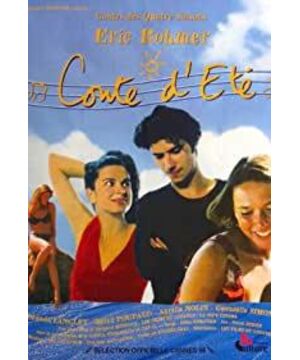(A part taken from one of my forum speeches)
A friend mentioned that the three girls are the real protagonists, while the male protagonist is a secondary supporting role, and then believes that the female protagonist corresponds to or symbolizes the three selves of the male protagonist Or three inner voices (I don't remember the original words, so I'm very sorry if the translation is wrong).
I'm also inclined to think that, in the deep structure of the story, the three women do present the possibility of being "corresponding to the hero's ego". But what I would like to say is that Rohmer does not use metaphors or symbols to achieve this structure like many other films. Rohmer's great place is actually here, and the interesting place is also here.
The so-called metaphors or symbolic expressions are most representative in two categories in movies, one is highly stylized movies, and the other is highly stylized art movies.
For the former, such as Westerns, no matter how the character setting and the use of the scene change, they follow the structural symbolic correspondence of good/evil, freedom/justice, anti-system/system, and anti-modern/modern. The latter such as Bergman, Tarkovsky and other speculative and poetic works. Metaphors abound in these mirror systems.
However, Rohmer's films are different from the former genre films and the latter art films. He does not use symbols and metaphors, but his films achieve the effect of triggering the association of symbols and metaphors. As the friend mentioned, we can abstract from the story of "Xia" that "the three women correspond to the three types of self-projections of the male protagonist". But we get this impression by watching a film that resembles a quasi-anthropological documentary.
So how did Rohmer do this?
Obviously he can't really get out of the genre film mode completely. He may have just turned the tangible into the intangible. In short, he still has the setting of "3 women", which means that he has not broken away from an allegorical or mythological structure, and thus has not broken away from a simple frame of storytelling and reasoning. However, he did not give the three women (that is, the supporting roles) any opportunity for self-interpretation, as in the genre films. On the contrary, he has given: the three women are all very strong "self-moral tellers", who have much clearer personal views than the male protagonists on the issue of morality, freedom and choice. In this way, these three women have escaped the stereotype by perhaps 30-40%. But what's very interesting is that Rohmer did not let them really get out of his "picture frame" and out of his limited view of "them in the eyes of the male protagonist".
In other words, the whole story is still seen through the eyes of the male protagonist; the whole story explores (or tells the story line) how he handles/chooses the relationship between the three women "in his eyes" and him.
So... (and here comes the best part -) We who watch Rohmer's films have a thematic structure that isn't the one-layered or over-the-top closed/semi-closed symbolic world of the Western genre, nor is it a lot of art films. It is a diffuse poetic structure in which metaphors and metaphors are intertwined. Rohmer's film structure is often the circular intersection structure of I have you and you have me.
Each character is a circle, and this circle makes itself visible by superimposing it on other circles. To put it simply, it means "The heroine A is the heroine A that the hero sees, the hero is the hero that the heroine B sees, the heroine C is the heroine C that the heroine A sees, and so on...
" In Xia, the circles of the three women seem to be in a state of squeezing each other. The reason why they squeeze each other is not because they are really three people fighting each other, but because they overlap in the circle of the male protagonist. In other words, the heroine ABC that the hero sees, the situation they are projected and arranged in the hero's mind, makes it impossible for the hero to identify and choose. The projection they represent corresponds to the hero's own personality arrangement.
Specifically, the male protagonist cannot accept a "circle" that overlaps the most with him, but is larger than him (the female doctor of ethnography preparatory course) because of his avoidance of a larger spiritual structure from the crowd, so he I chose to be her friend.
As for the second, the girl who took the initiative to pursue him, because of his cunning in human nature, he could not resist the "temptation of multiple-choice questions" from this girl, and always ended up slipping into a choice that he was not willing to do. This spiritual compromise was finally replaced by the "more perfect and more active pursuit" represented by the third woman, which made him regret again.
This kind of spiritual projection movement is exactly what Rohmer has been talking about all his life.
So the movie "Xia" is actually exploring another issue, which is to explore a typical spiritual structure by presenting a love story. I think this kind of discussion is universal as long as it is profound, and it is likely to achieve a deep resonance effect. This resonance itself is actually the common pursuit of "genre films and art films". The only difference is that art films are more suitable for showing a sense of division and diversity. Just like "Summer", it shows the "powerlessness" of the male protagonist to the spiritual issue of "selectivity/accidentity/variety". He would rather surrender himself to what he considers the chance, and let that chance take him away from this spiritual subject for which he is poor. But in fact, this kind of accident is not a real accident, but the absolute of this shore (circular closed spiritual structure), and no love can be produced in his absolute, and it cannot be extradited to the other shore (small island). This contingency on which he relies, seems to solve the problem, but is unable to achieve the perfect state in his heart (reaching his ideal island).
This mental structure was prescribed by himself, and he talked about it with relish. Love is just a subject. It's too much like our life. Therefore, Rohmer's films are good, not because they are a "dream", but because they explore the difficult reality of the delicate human brain and inner picture in the most elegant way.
The most important thing in this realistic picture is of course morality. Morality determines choice. In the male protagonist of "Xia", the "feeling of weakness" he has actually corresponds not to his real weak brain and character, but to his "morality". The other three women are not strong in character, but strong in moral pressure.
If there is a strong "point" in the male protagonist's mental picture, he will not be under pressure from three aspects, but it is precisely because of this invisible moral sense that has no "fixed point" that he faces "accident, fate". "It seems so stretched, full of questioning but self-indulgent and narcissistic.
I smeared some random thoughts, and I hope you will criticize more.
View more about A Summer's Tale reviews









